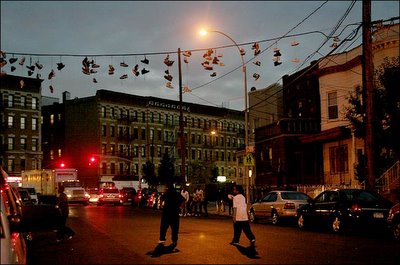 By MANNY FERNANDEZ
By MANNY FERNANDEZCHRISTOPHER CAMPBELL stood on a Bronx sidewalk and said that all told, he owned about 18 pairs of sneakers. Then he looked up. "Not counting the ones up there," he said.
Strung along a thick black wire across the street, a few dozen pairs of athletic shoes dangled by their laces about 25 feet above the ground for which they are manufactured. The utility line, near the intersection of Crotona Avenue and East 170th Street in the South Bronx, has acquired some 40 pairs of sneakers. They hang over the block like a rubber-soled welcome banner, Size 8 greetings from East 170th Street.
Six pairs belong to Christopher, one of a dozen teenagers in the neighborhood who have spent months - years in some cases - tossing their old, not-so-old and expensive footwear onto the wire. Some of them said they did it to claim the neighborhood as their own, to represent, one young man said, "the ghetto where we come from." Christopher, 16, hopes that years from now, he will return to the block and see his shoes up there.
"We really don't care who likes it or not," he said. "This is something for us."
Shoes-on-wires are a tradition as old as the notion of hanging utility lines on poles. No one knows who did it first or why. They decorate - some say deface - telephone, cable and power lines in neighborhoods from coast to coast. In the Bronx, the practice is particularly popular, one sign amid the borough's economic revitalization of its grittier past.
Theories about the meaning of shoe-tossing are countless. It has been rumored to be a marker of gang or drug territory, but Detective Walter Burnes, a spokesman for the New York Police Department, said he never heard of someone using sneakers to publicize a drug corner. "I don't think it's the sort of thing that people advertise by leaving a sign," Detective Burnes said. (Another spokesman pointed out, though, that the practice itself could be considered criminal mischief.)
People who live near shoe-lined wires speculate that it is a last-day-of-school tradition or a trophy collection of the shoes of mugging victims. Others said the ritual had no meaning beyond the fact that neighborhood youth were bored and not respectful. "I think it's disgusting," said Elizabeth Dean, 52, who lives almost under the utility line crossing Crotona Avenue.
Con Edison tries to keep its 36,000 miles of overhead electrical wires in New York City and Westchester County as shoe-free as possible, a spokesman said, and representatives for Verizon and Cablevision said the phenomenon was not a major problem for them.
Christopher and his friends noted that contrary to urban legend, the tradition on their block had nothing to do with criminal activity. They take pride in their project.
"See how there's gaps?" he said. "We don't like that."
So the next afternoon, Christopher returned with a pair of black-and-white Charles Barkley edition Nikes. He tied the laces in a double knot. Then he flung them, and flung them again, until the long white laces caught the wire.
That's a great shot. My son always queries about the source of such misplaced footwear when we see a pair. The only example I can ever conjure up is when the bullies used to force the shoes off some poor kid on the back of the city bus after a high-school football game. Then they disposed of them, and he walked home from the bus stop in his socks. In november.
ReplyDeleteOther than that, boredom.
They make a cool silhouette against the orangey urban sky, don't they?
Although in a lot of ways it seems like a waste of perfectly good sneakers, I think it's a powerful image and I can see the point of marking one's territory. Most people do it here with junk cars and furniture on the porch.
ReplyDelete